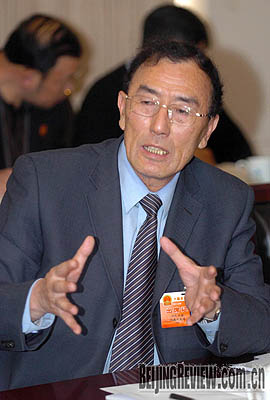|

"Human rights' protection in Tibet is at its best," said Qiangba Puncog, Chairman of Tibet Autonomous Region
WANG YEBIAO
People of various ethnic groups living in Tibet have benefited from reform and development, Qiangba Puncog, Chairman of the Tibet Autonomous Region, said at a recent press conference in Beijing.
"They are the real beneficiaries," he said, citing figures on Tibet's development to counter the Dalai Lama's claims of "cultural genocide" and that the benefits of Tibet's development have been taken away by Han people.
"The Dalai Lama's claims are lies to instigate antagonism between various ethnic groups and to cheat the international community," the chairman said.
Over the past seven years, Tibet's gross domestic product (GDP) has grown by more than 12 percent a year. Last year, its GDP was 34.2 billion yuan ($4.88 billion) and its per-capita GDP 12,000 yuan ($1,710), he said at the news conference.
In the past five years, the Central Government has given Tibet 94.7 billion yuan ($13.5 million) in subsidies and spent 60.1 billion yuan ($8.6 billion) on infrastructure construction, he said. The Central Government has also spent over 700 million yuan ($100 million) over the last 20 years on the renovation and protection of temples, cultural heritage and other religious venues.
Tibet's primary school enrollment rate is 98.2 percent and junior middle school rate is 90.7 percent. All primary middle and junior middle school students in Tibet enjoy free tuition and boarding.
The average life expectancy for people in Tibet is now 67, up from 35.5 in the 1950s, he said. The total number of Tibetans is 2.5 million-about 95 percent of the region's total population-up from 1.2 million in 1964, Qiangba Puncog said. Tibet has led the country in establishing a basic living allowance system covering all farmers and herdsmen, under which 230,000 people with an annual net income of less than 800 yuan ($114.3) enjoy benefits. Tibet also became the first region in China to realize 100-percent coverage of medical insurance among its rural and urban residents.
Last year, after double-digit annual growth for successive five years, the average income of farmers and herdsmen was 2,788 yuan ($398), he said. (More figures of Tibet on www.bjreview.com)
By the end of last year, 612 townships-almost 90 percent of the total-had been connected by roads, and all townships had been linked by telephone.
Since the Tibetan government launched resettlement programs in 2006, more than 590,000 farmers have moved into government-subsidized new homes.
"After the March 14 riots in Lhasa, the various ethnic groups in Tibet will have a deeper understanding that stability will bring them fortune while turbulence will only bring them misfortune," he said.
"No matter what happens, our determination to safeguard the unity of the motherland, protect ethnic groups and preserve social stability will remain unchanged."
Answering questions from the media, Qiangba Puncog said he believed human rights' protection in Tibet is at its best. Using his own family as an example, he said he was born to a poor family of vegetable serfs in the eastern part of Tibet under the feudal serf system and had been told on how painful the past life was for the family by his parents. He credited his opportunity to receive education and his current job as a government official to the liberation of Tibet.
"Those going through the chilly winter can better appreciate the warmth of sunshine. Older people in Tibet, who lived under the feudal serf system, could better appreciate today's life," said he.
The government of Tibet Autonomous Region has paid out 3 million yuan ($429,000) in compensation to the families of 15 people killed in the riots that erupted on March 14.
A report by China Central Television on March 30 said Tibet's regional government has adopted supportive measures to help businessmen recover from the March 14 riot. Those who had business losses will not have to pay any business tax, enterprise income tax or individual income tax for two years. Besides paying part of the property rent, the government will also distribute interest subsides to riot-affected proprietors who take out loans of less than 1 million yuan ($143,000). | 